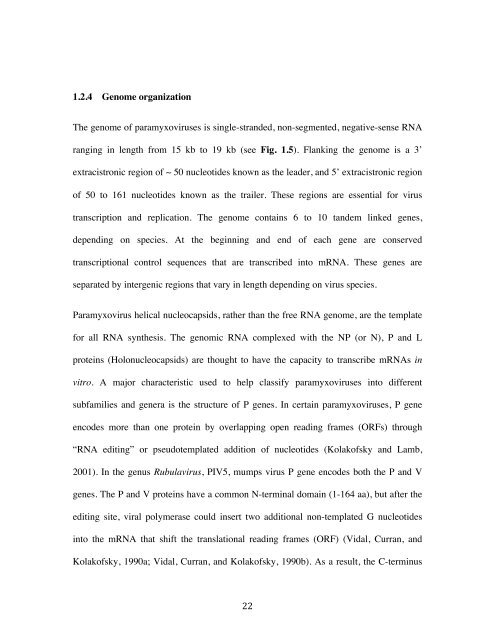Han Xiao PhD thesis - Research@StAndrews:FullText - University of ...
Han Xiao PhD thesis - Research@StAndrews:FullText - University of ...
Han Xiao PhD thesis - Research@StAndrews:FullText - University of ...
You also want an ePaper? Increase the reach of your titles
YUMPU automatically turns print PDFs into web optimized ePapers that Google loves.
1.2.4 Genome organization<br />
The genome <strong>of</strong> paramyxoviruses is single-stranded, non-segmented, negative-sense RNA<br />
ranging in length from 15 kb to 19 kb (see Fig. 1.5). Flanking the genome is a 3’<br />
extracistronic region <strong>of</strong> ∼ 50 nucleotides known as the leader, and 5’ extracistronic region<br />
<strong>of</strong> 50 to 161 nucleotides known as the trailer. These regions are essential for virus<br />
transcription and replication. The genome contains 6 to 10 tandem linked genes,<br />
depending on species. At the beginning and end <strong>of</strong> each gene are conserved<br />
transcriptional control sequences that are transcribed into mRNA. These genes are<br />
separated by intergenic regions that vary in length depending on virus species.<br />
Paramyxovirus helical nucleocapsids, rather than the free RNA genome, are the template<br />
for all RNA syn<strong>thesis</strong>. The genomic RNA complexed with the NP (or N), P and L<br />
proteins (Holonucleocapsids) are thought to have the capacity to transcribe mRNAs in<br />
vitro. A major characteristic used to help classify paramyxoviruses into different<br />
subfamilies and genera is the structure <strong>of</strong> P genes. In certain paramyxoviruses, P gene<br />
encodes more than one protein by overlapping open reading frames (ORFs) through<br />
“RNA editing” or pseudotemplated addition <strong>of</strong> nucleotides (Kolak<strong>of</strong>sky and Lamb,<br />
2001). In the genus Rubulavirus, PIV5, mumps virus P gene encodes both the P and V<br />
genes. The P and V proteins have a common N-terminal domain (1-164 aa), but after the<br />
editing site, viral polymerase could insert two additional non-templated G nucleotides<br />
into the mRNA that shift the translational reading frames (ORF) (Vidal, Curran, and<br />
Kolak<strong>of</strong>sky, 1990a; Vidal, Curran, and Kolak<strong>of</strong>sky, 1990b). As a result, the C-terminus<br />
<br />
22
















